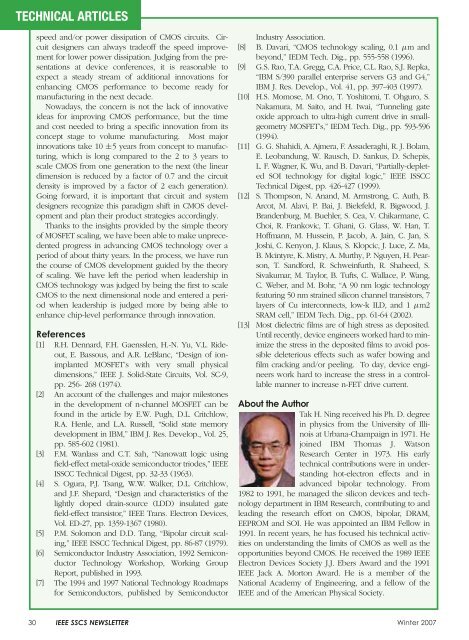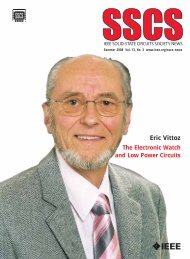The Impact of Dennard's Scaling Theory - IEEE
The Impact of Dennard's Scaling Theory - IEEE
The Impact of Dennard's Scaling Theory - IEEE
- TAGS
- scaling
- www.ieee.org
Create successful ePaper yourself
Turn your PDF publications into a flip-book with our unique Google optimized e-Paper software.
TECHNICAL ARTICLES<br />
speed and/or power dissipation <strong>of</strong> CMOS circuits. Circuit<br />
designers can always trade<strong>of</strong>f the speed improvement<br />
for lower power dissipation. Judging from the presentations<br />
at device conferences, it is reasonable to<br />
expect a steady stream <strong>of</strong> additional innovations for<br />
enhancing CMOS performance to become ready for<br />
manufacturing in the next decade.<br />
Nowadays, the concern is not the lack <strong>of</strong> innovative<br />
ideas for improving CMOS performance, but the time<br />
and cost needed to bring a specific innovation from its<br />
concept stage to volume manufacturing. Most major<br />
innovations take 10 ±5 years from concept to manufacturing,<br />
which is long compared to the 2 to 3 years to<br />
scale CMOS from one generation to the next (the linear<br />
dimension is reduced by a factor <strong>of</strong> 0.7 and the circuit<br />
density is improved by a factor <strong>of</strong> 2 each generation).<br />
Going forward, it is important that circuit and system<br />
designers recognize this paradigm shift in CMOS development<br />
and plan their product strategies accordingly.<br />
Thanks to the insights provided by the simple theory<br />
<strong>of</strong> MOSFET scaling, we have been able to make unprecedented<br />
progress in advancing CMOS technology over a<br />
period <strong>of</strong> about thirty years. In the process, we have run<br />
the course <strong>of</strong> CMOS development guided by the theory<br />
<strong>of</strong> scaling. We have left the period when leadership in<br />
CMOS technology was judged by being the first to scale<br />
CMOS to the next dimensional node and entered a period<br />
when leadership is judged more by being able to<br />
enhance chip-level performance through innovation.<br />
References<br />
[1] R.H. Dennard, F.H. Gaensslen, H.-N. Yu, V.L. Rideout,<br />
E. Bassous, and A.R. LeBlanc, “Design <strong>of</strong> ionimplanted<br />
MOSFET’s with very small physical<br />
dimensions,” <strong>IEEE</strong> J. Solid-State Circuits, Vol. SC-9,<br />
pp. 256- 268 (1974).<br />
[2] An account <strong>of</strong> the challenges and major milestones<br />
in the development <strong>of</strong> n-channel MOSFET can be<br />
found in the article by E.W. Pugh, D.L. Critchlow,<br />
R.A. Henle, and L.A. Russell, “Solid state memory<br />
development in IBM,” IBM J. Res. Develop., Vol. 25,<br />
pp. 585-602 (1981).<br />
[3] F.M. Wanlass and C.T. Sah, “Nanowatt logic using<br />
field-effect metal-oxide semiconductor triodes,” <strong>IEEE</strong><br />
ISSCC Technical Digest, pp. 32-33 (1963).<br />
[4] S. Ogura, P.J. Tsang, W.W. Walker, D.L. Critchlow,<br />
and J.F. Shepard, “Design and characteristics <strong>of</strong> the<br />
lightly doped drain-source (LDD) insulated gate<br />
field-effect transistor,” <strong>IEEE</strong> Trans. Electron Devices,<br />
Vol. ED-27, pp. 1359-1367 (1980).<br />
[5] P.M. Solomon and D.D. Tang, “Bipolar circuit scaling,”<br />
<strong>IEEE</strong> ISSCC Technical Digest, pp. 86-87 (1979).<br />
[6] Semiconductor Industry Association, 1992 Semiconductor<br />
Technology Workshop, Working Group<br />
Report, published in 1993.<br />
[7] <strong>The</strong> 1994 and 1997 National Technology Roadmaps<br />
for Semiconductors, published by Semiconductor<br />
Industry Association.<br />
[8] B. Davari, “CMOS technology scaling, 0.1 μm and<br />
beyond,” IEDM Tech. Dig., pp. 555-558 (1996).<br />
[9] G.S. Rao, T.A. Gregg, C.A. Price, C.L. Rao, S.J. Repka,<br />
“IBM S/390 parallel enterprise servers G3 and G4,”<br />
IBM J. Res. Develop., Vol. 41, pp. 397-403 (1997).<br />
[10] H.S. Momose, M. Ono, T. Yoshitomi, T. Ohguro, S.<br />
Nakamura, M. Saito, and H. Iwai, “Tunneling gate<br />
oxide approach to ultra-high current drive in smallgeometry<br />
MOSFET’s,” IEDM Tech. Dig., pp. 593-596<br />
(1994).<br />
[11] G. G. Shahidi, A. Ajmera, F. Assaderaghi, R. J. Bolam,<br />
E. Leobandung, W. Rausch, D. Sankus, D. Schepis,<br />
L. F. Wagner, K. Wu, and B. Davari, “Partially-depleted<br />
SOI technology for digital logic,” <strong>IEEE</strong> ISSCC<br />
Technical Digest, pp. 426-427 (1999).<br />
[12] S. Thompson, N. Anand, M. Armstrong, C. Auth, B.<br />
Arcot, M. Alavi, P. Bai, J. Bielefeld, R. Bigwood, J.<br />
Brandenburg, M. Buehler, S. Cea, V. Chikarmane, C.<br />
Choi, R. Frankovic, T. Ghani, G. Glass, W. Han, T.<br />
H<strong>of</strong>fmann, M. Hussein, P. Jacob, A. Jain, C. Jan, S.<br />
Joshi, C. Kenyon, J. Klaus, S. Klopcic, J. Luce, Z. Ma,<br />
B. Mcintyre, K. Mistry, A. Murthy, P. Nguyen, H. Pearson,<br />
T. Sandford, R. Schweinfurth, R. Shaheed, S.<br />
Sivakumar, M. Taylor, B. Tufts, C. Wallace, P. Wang,<br />
C. Weber, and M. Bohr, “A 90 nm logic technology<br />
featuring 50 nm strained silicon channel transistors, 7<br />
layers <strong>of</strong> Cu interconnects, low-k ILD, and 1 μm2<br />
SRAM cell,” IEDM Tech. Dig., pp. 61-64 (2002).<br />
[13] Most dielectric films are <strong>of</strong> high stress as deposited.<br />
Until recently, device engineers worked hard to minimize<br />
the stress in the deposited films to avoid possible<br />
deleterious effects such as wafer bowing and<br />
film cracking and/or peeling. To day, device engineers<br />
work hard to increase the stress in a controllable<br />
manner to increase n-FET drive current.<br />
About the Author<br />
Tak H. Ning received his Ph. D. degree<br />
in physics from the University <strong>of</strong> Illinois<br />
at Urbana-Champaign in 1971. He<br />
joined IBM Thomas J. Watson<br />
Research Center in 1973. His early<br />
technical contributions were in understanding<br />
hot-electron effects and in<br />
advanced bipolar technology. From<br />
1982 to 1991, he managed the silicon devices and technology<br />
department in IBM Research, contributing to and<br />
leading the research effort on CMOS, bipolar, DRAM,<br />
EEPROM and SOI. He was appointed an IBM Fellow in<br />
1991. In recent years, he has focused his technical activities<br />
on understanding the limits <strong>of</strong> CMOS as well as the<br />
opportunities beyond CMOS. He received the 1989 <strong>IEEE</strong><br />
Electron Devices Society J.J. Ebers Award and the 1991<br />
<strong>IEEE</strong> Jack A. Morton Award. He is a member <strong>of</strong> the<br />
National Academy <strong>of</strong> Engineering, and a fellow <strong>of</strong> the<br />
<strong>IEEE</strong> and <strong>of</strong> the American Physical Society.<br />
30 <strong>IEEE</strong> SSCS NEWSLETTER Winter 2007




